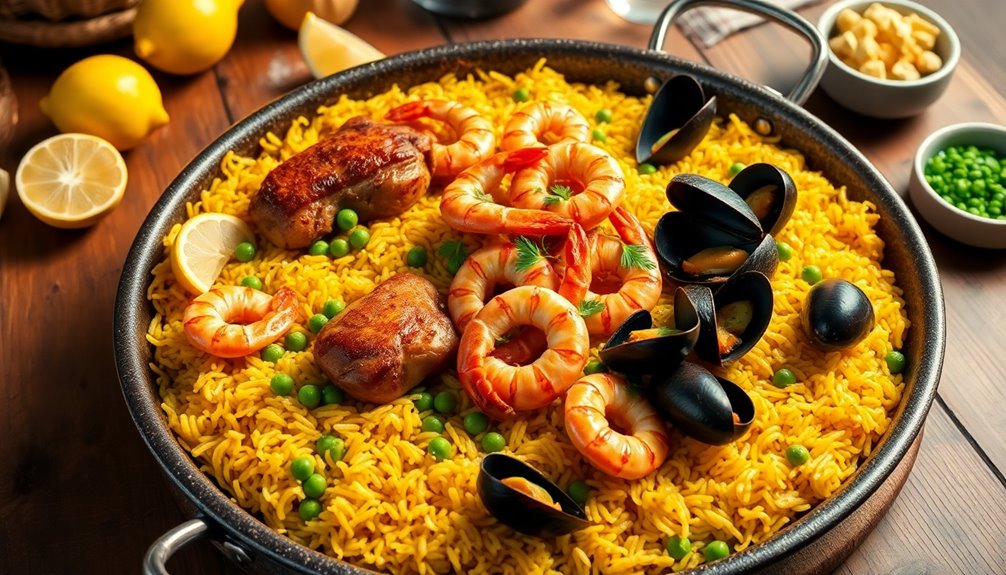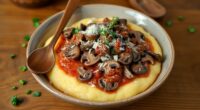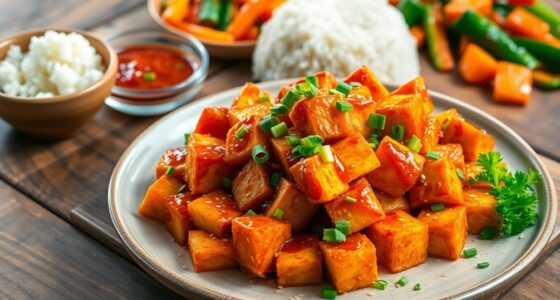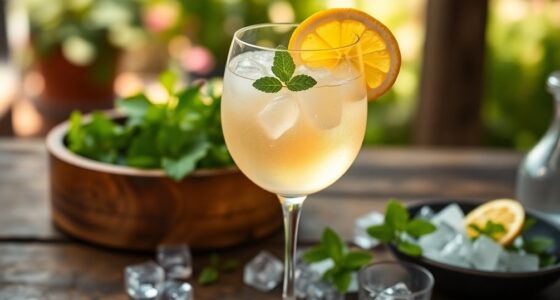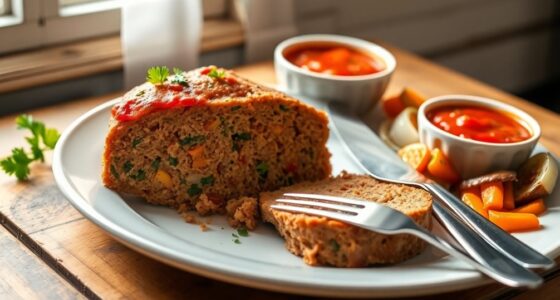Classic paella is a vibrant dish originating from Valencia, Spain, and is known for its rich flavors and communal dining spirit. You'll use bomba rice, saffron, and a mix of proteins like chicken and seafood, cooked in a special paella pan. Once you master the technique, the result is a beautiful, socarrat-crusted meal that brings everyone together. It's versatile, too, allowing you to mix ingredients as you wish. There's so much more to explore about this treasured dish!
History
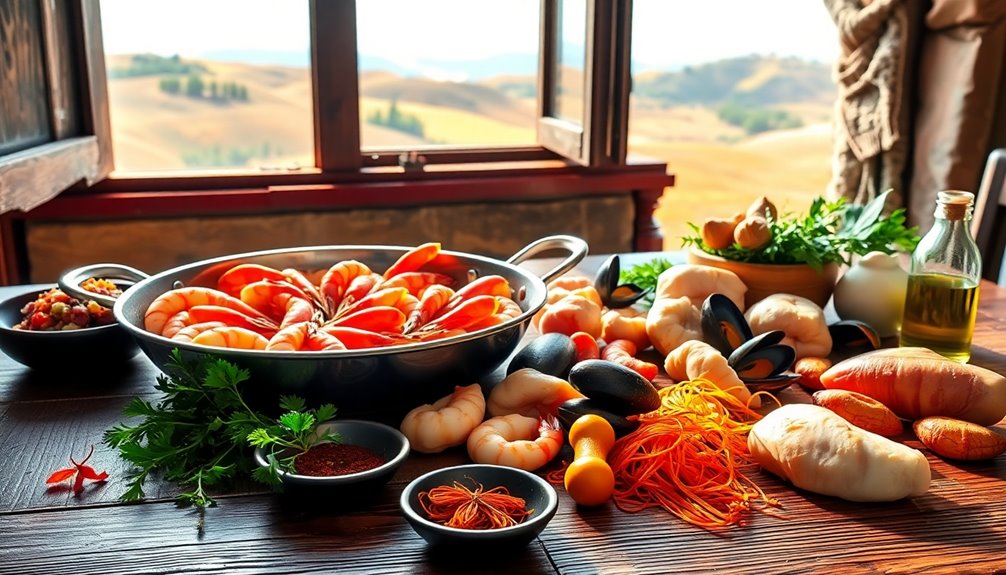
Paella's history is as rich and flavorful as the dish itself, originating in the mid-19th century in Valencia, Spain.
This traditional Spanish dish was initially a simple meal prepared by farmers and laborers using rice cooked over an open fire, featuring easily accessible ingredients like rabbit, snails, and vegetables.
The name "paella" comes from the "paellera," the wide, shallow pan essential for achieving that perfect socarrat texture.
As trade flourished, saffron was introduced, enhancing the dish's vibrant color and distinct flavor.
Over the years, paella evolved, adapting to local ingredients and giving rise to various regional variations, like seafood paella, which showcases the fresh fish and shellfish found in the Mediterranean.
Recipe
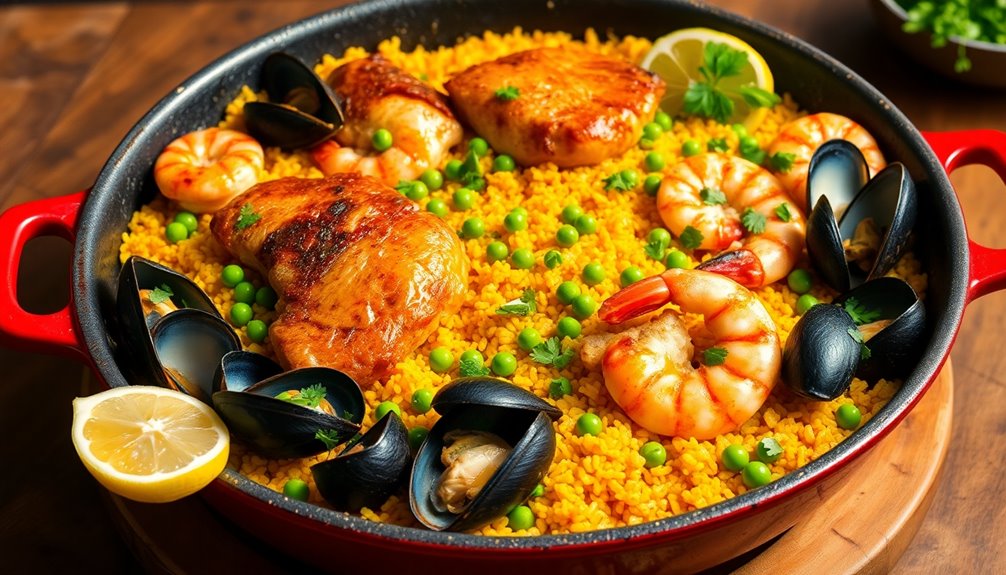
Ingredients
- 2 cups bomba or calaspara rice
- 4 cups chicken or seafood broth
- 1/2 teaspoon saffron threads
- 1 pound chicken thighs, bone-in, skin-on, cut into pieces
- 1 pound shrimp, peeled and deveined
- 1 cup mussels, cleaned
- 1 cup clams, cleaned
- 1 medium onion, diced
- 3 cloves garlic, minced
- 1 red bell pepper, diced
- 1 cup green peas
- 1 teaspoon smoked paprika
- Olive oil
- Salt and pepper to taste
- Lemon wedges for garnish
- Fresh parsley, chopped for garnish
Cooking Instructions
In a large paella pan or wide skillet, heat a generous drizzle of olive oil over medium heat.
Add the diced onion, red bell pepper, and minced garlic, sautéing until softened and fragrant.
Stir in the smoked paprika and saffron threads, then add the chicken pieces, cooking until browned on all sides.
Add the rice, stirring to coat it with the oil and flavors, followed by the broth.
Bring to a simmer, season with salt and pepper, and reduce heat to low.
Avoid stirring from this point to allow the socarrat to form.
After about 10 minutes, arrange the shrimp, mussels, and clams on top of the rice.
Cook for an additional 10-15 minutes until the seafood is cooked through, the rice is tender, and a golden crust has formed at the bottom.
Remove from heat and let it rest for a few minutes before serving, garnished with lemon wedges and fresh parsley.
Extra Tips
For the best socarrat, keep a close eye on the heat during the final few minutes of cooking and adjust as needed.
If you find that the rice is cooking too quickly or starting to burn, lower the heat.
Additionally, feel free to customize your paella with your favorite proteins or vegetables; just be mindful of cooking times to ascertain everything is perfectly cooked.
Finally, serving paella straight from the pan adds to the communal experience, so gather around and enjoy the rich flavors and textures together!
Cooking Steps
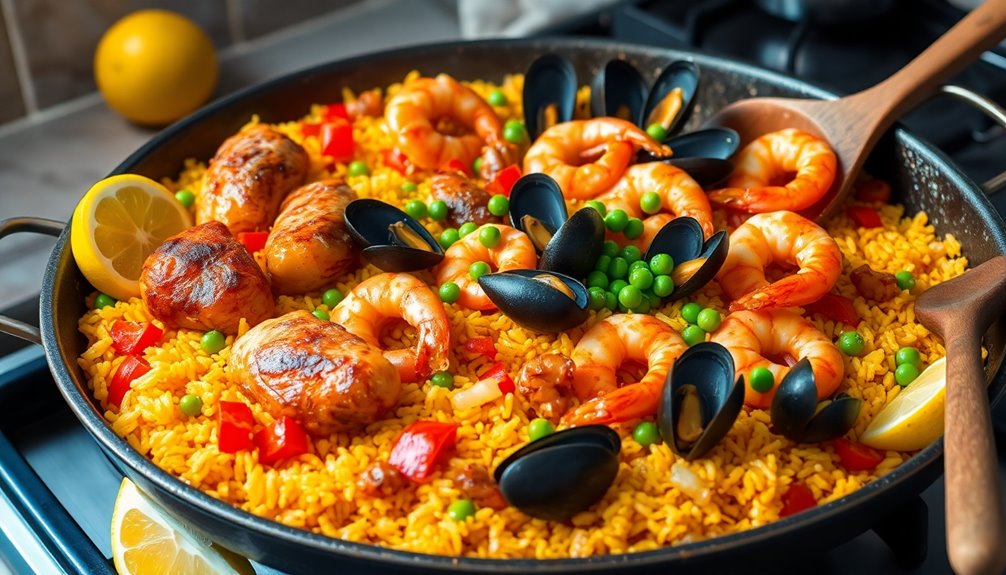
Let's get into the cooking steps for your classic paella.
You'll start by preparing your ingredients and adding saffron to the broth, which will give your dish that signature color and flavor.
Once everything's ready, you can stir in the rice, followed by the proteins and vegetables, then let it simmer until the rice absorbs all that delicious liquid.
Step 1. Prepare Ingredients for Cooking
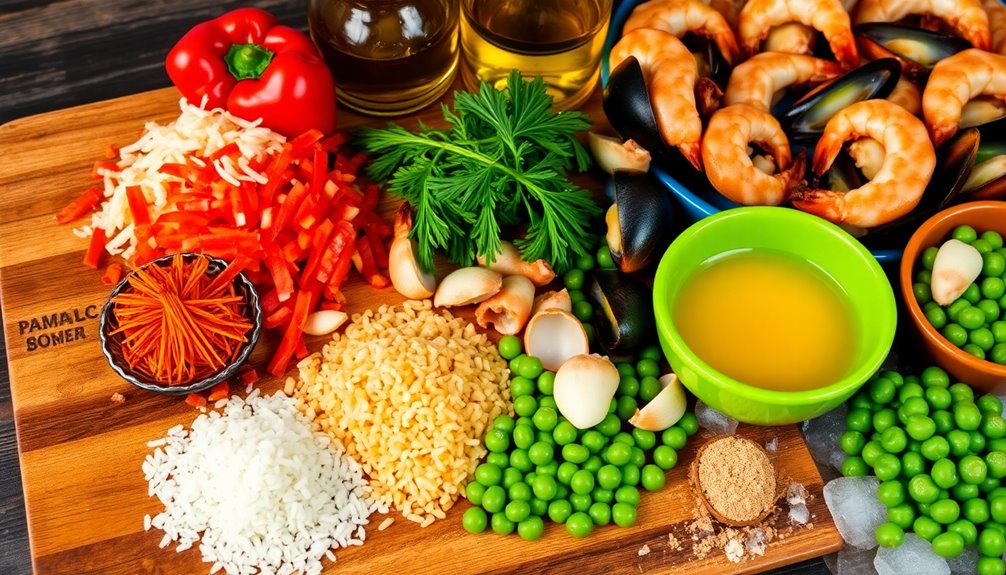
Before diving into the cooking process, it's essential to prepare all your ingredients. Start by gathering the main components like Spanish round rice, saffron, chicken thighs, and a variety of seafood such as shrimp and mussels.
Next, chop your onion, bell pepper, and garlic, and have fresh or canned tomatoes ready. Measure out your spices, including smoked paprika, bay leaf, salt, and pepper, so they're within reach.
If you're using seafood, make sure it's cleaned and thawed. Don't forget any additional proteins, like chorizo or rabbit, prepped for cooking.
Finally, warm your chicken broth or seafood broth, as this will be important for bringing rich flavor to your classic paella.
Step 2. Add Saffron to Broth
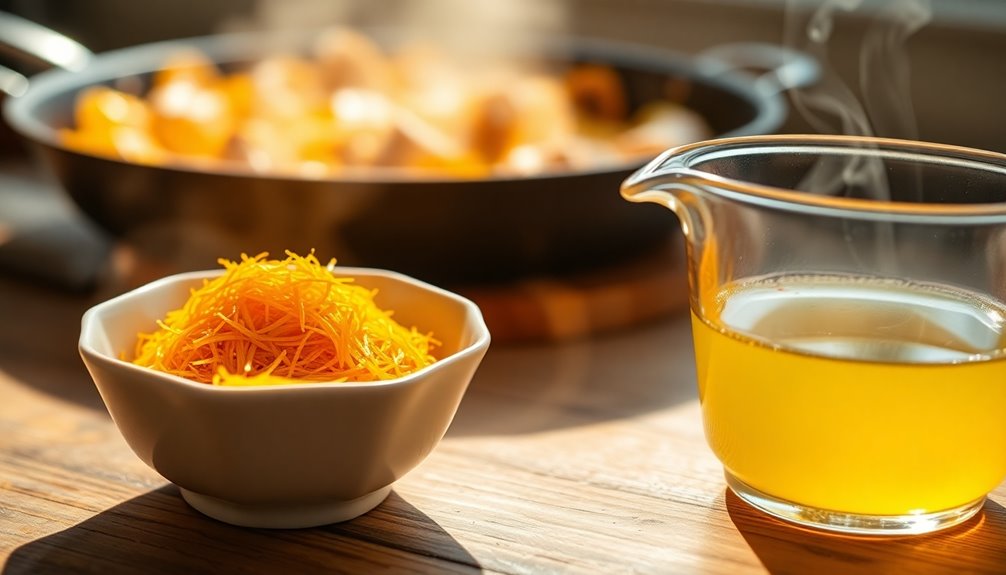
With your ingredients prepped and ready, it's time to elevate the broth that will infuse your paella with rich flavor.
Start by warming your broth gently and then add a pinch of high-quality Spanish saffron threads. This key ingredient not only enhances the taste but also gives your dish that characteristic golden color.
Allow the saffron to steep in the broth for at least 10 minutes; this step is essential for fully releasing its vibrant flavor and hue. For a standard paella serving 4-6 people, about 1/4 to 1/2 teaspoon of saffron is sufficient.
Step 3. Stir in the Rice
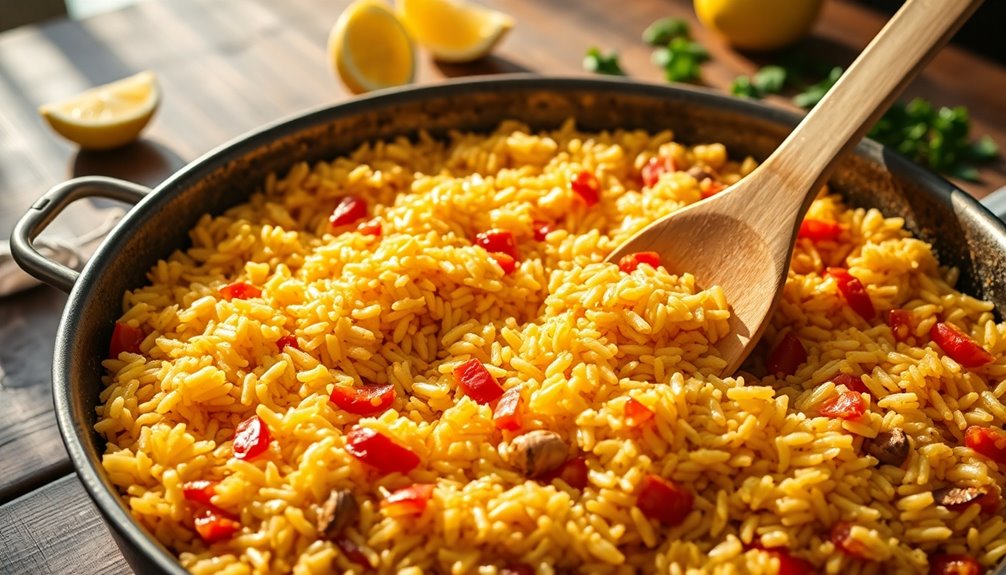
Gently fold in the rice, ensuring each grain gets coated with the aromatic mixture of sautéed vegetables and spices.
Stir the rice for about 1 minute, allowing it to absorb those delicious flavors.
Next, pour the chicken or seafood broth around the rice, being careful not to stir. Instead, gently jiggle the pan to create an even layer; this technique helps develop the socarrat, that coveted crust at the bottom.
Cook the rice uncovered over medium heat for about 10-15 minutes, letting it absorb most of the liquid.
Keep a close eye during the final minutes to achieve the perfect socarrat, adjusting the heat as necessary for that delightful, crispy finish.
Enjoy the process!
Step 4. Add Proteins and Vegetables
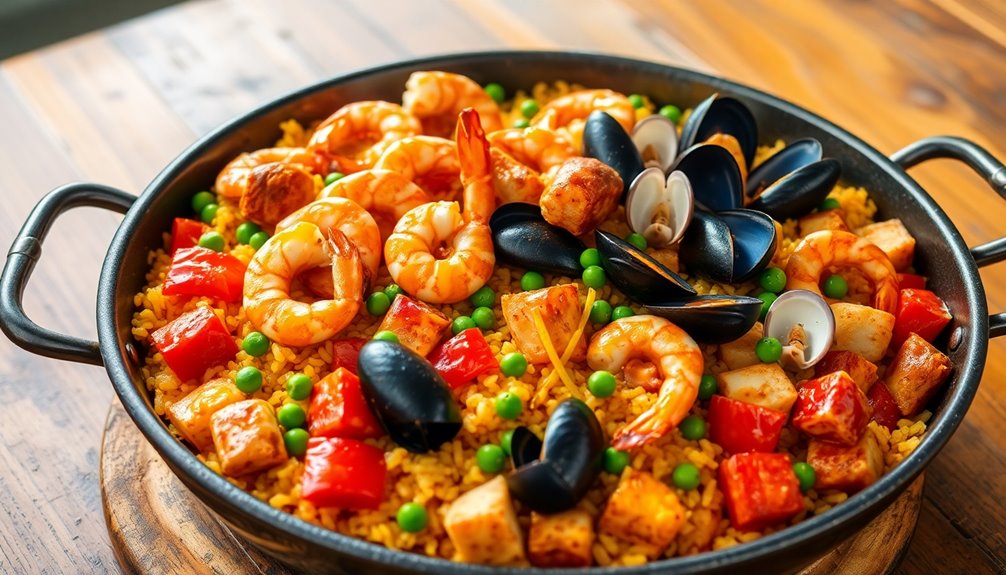
As you prepare to elevate your paella, start by sautéing chicken thighs and chorizo in olive oil until they're golden brown; this step enhances their flavor and adds depth to the dish.
Next, add proteins and vegetables by incorporating colorful bell peppers, onions, and tomatoes, cooking them until they soften. This creates a rich, flavorful base for your paella.
If you're opting for a seafood version, wait until the rice is added and the broth is simmering, then introduce fresh or thawed shrimp, mussels, and calamari, allowing them to cook until their shells open.
Remember to evenly distribute the proteins and vegetables throughout the rice for even cooking, but avoid stirring once the broth is added to achieve that perfect socarrat.
Step 5. Simmer Until Rice Absorbs Liquid
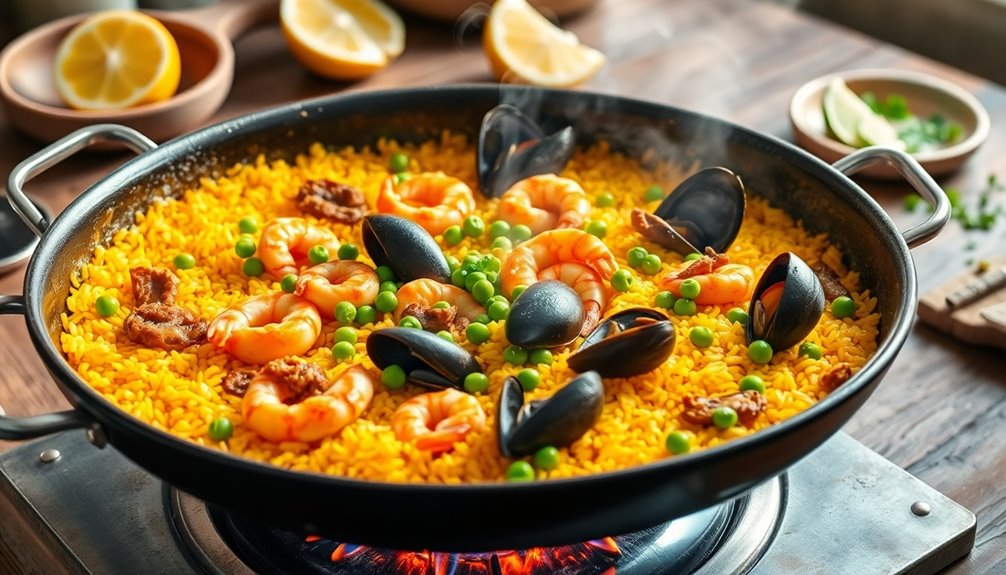
After adding your proteins and vegetables, it's time to focus on the simmering process.
Bring the pan to a boil over high heat, then reduce the heat to low. Allow the rice to simmer uncovered for about 15-20 minutes, or until most of the liquid is absorbed.
Avoid stirring during this phase; it helps develop the socarrat, the delicious, crusty layer at the bottom.
Check the rice for doneness by tasting—it should be al dente, with a slight firmness. If the rice is still hard or the liquid evaporates too quickly, add additional broth or water in small increments.
This way, you'll guarantee your paella turns out perfectly cooked and flavorful!
Final Thoughts
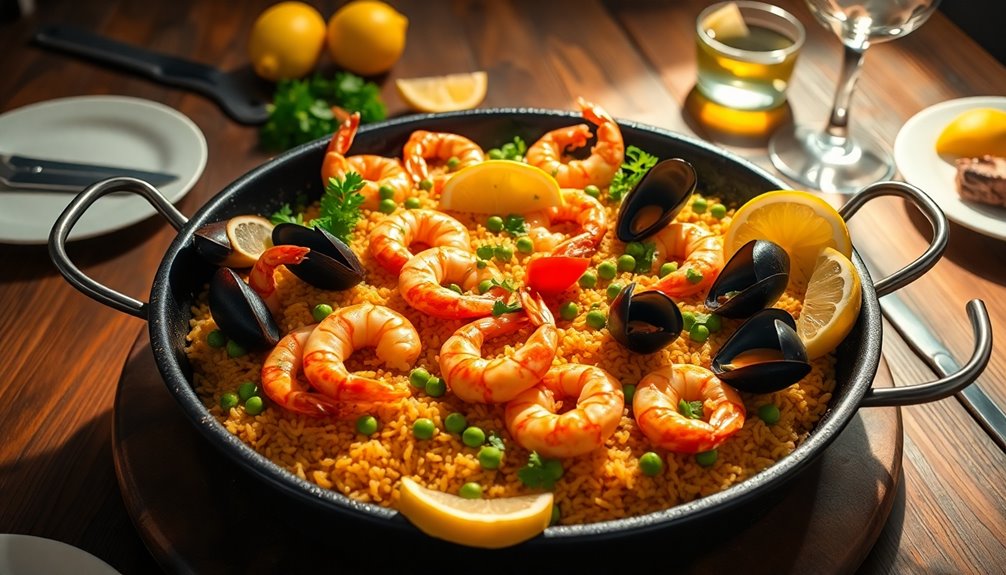
Crafting a classic paella isn't just about following a recipe; it's an invitation to embrace a rich culinary tradition that celebrates community and flavor.
When you immerse yourself in an authentic paella recipe, you're not just cooking; you're creating a dish that brings people together. The joy of sharing a perfect paella, complete with that signature socarrat, enhances every meal.
Remember, paella is versatile—feel free to mix proteins or adapt the recipe to your taste. Using high-quality ingredients like bomba rice and saffron guarantees good food that impresses.
While mastering this dish takes practice, the satisfaction of serving a beautiful paella to friends and family makes every effort worthwhile.
Frequently Asked Questions
What Is in a Classic Paella?
When you think about what's in a classic dish, you'll find a mix of essential ingredients.
You've got rice that soaks up flavors, proteins like chicken or seafood, and vibrant vegetables like bell peppers and tomatoes.
Don't forget the spices, especially saffron, which gives it that unique taste and color.
Homemade broth ties everything together, creating a rich, savory experience.
Plus, you get that crispy layer of rice at the bottom for added texture!
What Is the Most Traditional Paella?
Imagine a sunlit field, where tradition and flavor intertwine like the vibrant colors of a Spanish sunset.
The most traditional paella hails from Valencia, featuring chicken, rabbit, and green beans, all infused with saffron's golden touch.
You'll find it cooked in a wide, shallow pan over an open flame, creating that coveted crispy socarrat.
This dish, born from local agricultural roots, embodies the heart and soul of rustic Spanish cuisine.
What Are the Three Types of Paella?
There are three main types of paella you should know about.
First, there's Paella Valenciana, which features chicken, rabbit, and green beans, representing traditional flavors.
Next, you have Seafood Paella, packed with shrimp, mussels, and calamari for a lighter touch.
Finally, Mixed Paella combines both meat and seafood, offering a rich variety of tastes.
Each type uses bomba rice, essential for that perfect texture and flavor absorption you'll love!
What Was Originally in Paella?
Originally, paella was like a canvas for farmers, using whatever ingredients they'd on hand.
You'd find rice as the base, complemented by local vegetables and proteins such as rabbit or snails. Saffron added vibrant color and flavor, while green beans reflected the region's agriculture.
This humble dish, cooked over an open fire in a wide, shallow pan, showcased resourcefulness, turning simple ingredients into a communal meal that brought people together.
